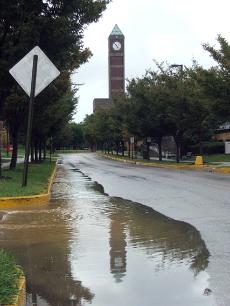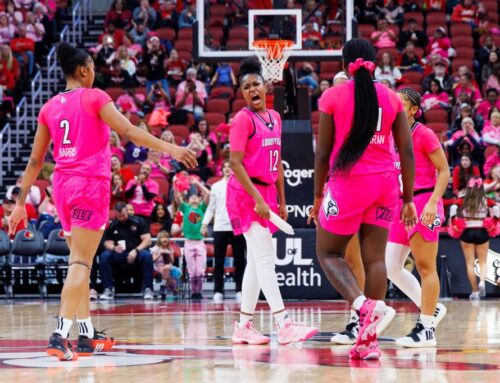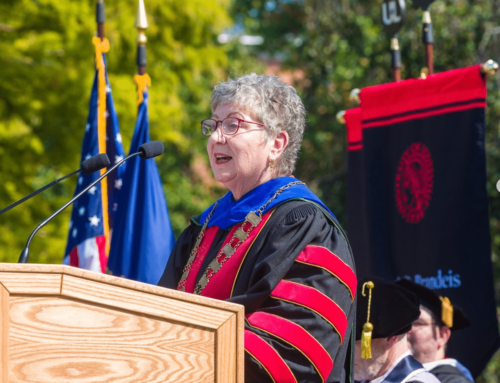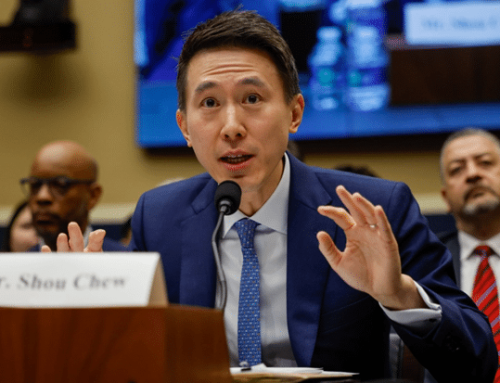Water, water everywhere, but not a drop to drink.
Over the weekend, torrential rains washed into southern Indiana and north and central Kentucky, causing flash floods that submerged portions of the east side of the University of Louisville Belknap campus.
Almost eight inches of rain drenched Louisville in the first round of storms late last Friday night.
The Brandeis Avenue/Cardinal Boulevard underpass between Floyd and Brook Streets quickly became a lake, with the flood markings totally out of sight on the side of the concrete trusses supporting the railroad tracks.
Police barricaded the roadways on both sides to keep automobiles and drivers from attempting to pass through the water.
“Just amazing,” said senior Math major Kyle Powell. “We saw the water all the way up to the bottom of the underpass and still more coming up from the manhole covers. The water coming out of the manhole cover had such pressure it was shooting one or two feet into the air.”
Motorists in the area – even those who didn’t try to ford the worst of the rising waters – were stuck on streets in some places around the campus.
But lucky for them, some students offered a helping hand during their time of need.
Members of the Baptist Christian Ministry emerged from their building at around midnight to help push cars out of the rising flood waters.
“It was ridiculous.” said Andrew Chacko, a junior Biology major. “A group of us went out and helped push cars out and had fun.”
Josh Yuen, another BCM member and junior biology major said, “It rained a lot and flooded for a while, but by morning it was gone.”
Rains and road-closures caused many students to have to change routes to come to campus. Freshman marketing major David Bell, a member of the swim team, said many of his teammates were stuck inside their houses due to flood waters. He said he and some of his friends visited the Brandeis Street underpass late Friday night.
“The water was so high you could touch it with your hands from the bridge,” he said.
Floyd and Brook Streets were also veritable rivers, with several cars and trucks stopped in water up to their windows. Many drivers attempted to pass through the streams, but when their engines stalled they apparently abandoned their cars.
Sewers around the university spewed water they could not handle back into the streets and sidewalks.
The section of Brook Street that runs in front of the Houchens building retained at least three and a half feet of water, forcing students to wade waist deep through the murky water.
According to physical plant worker Phil Myers, many of the buildings on Brook Street sustained water damage.
“I’ve got two gas powered pumps pumping water out of [Crawford Gym,]” he said.
The Chemistry Building, Houchens Building and the University Club were also reportedly damaged.
But not only were buildings at risk, student safety became a concern as well when some students saw the flood as a chance for fun in the rain.
“Those manhole covers blow out,” Myers said, to aid in the drainage of rising water. He said the missing covers create suction that helps to relieve flood situations.
“If you happen to walk over one of them, especially when you can’t see them, they’ll suck you right down,” he said. “You’ll be out in the river.”
The waters receded some by Saturday morning, but another batch of downpours during that afternoon raised water levels a little once more that day.
U of L was not the only sufferer of the rains. Flooding occurred throughout the state, with evacuations occurring in at least four counties, including some in the Louisville-Jefferson County metro area.
The American Red Cross opened a severe weather shelter at Seneca High School in Louisville last Friday night, and provided assistance for about 110 local residents.
At press time, at least eight deaths related to the storms and flood waters had been reported in the state.






